Gartner predicts that over one-third of large organizations will be using decision intelligence within the next two years, making it an exciting time for businesses to explore potential applications for adoption.
Generally, many organizations make data-driven business decisions following a four-step process, including:
- Data collection
- Data mining with some tool combinations
- Analyzing data with dashboards and visualization
- Data interpretation
The information generated with the above process enlightens the organization with some crucial information, but they are still left questioning what to do with the information they have learned. The dependency on the wide range of tools, systems, integration, and workaround creates huge confusion and leaves organizations with more questions than answers.
The volume of data being created, consumed, and stored worldwide is skyrocketing, with a projected increase of over 50% by 2025. Businesses recognize the importance of leveraging their data more effectively for a competitive advantage. The key to unlocking this potential lies in implementing artificial intelligence (AI) rather than relying on traditional business intelligence (BI).
However, despite the significant investment in AI talent by Fortune 500 companies, only 10% of machine learning models are being implemented in organizations, resulting in a gap between AI theory and practical application.
To bridge this gap, decision intelligence technology is now available to help companies apply AI to their decision-making processes.
Critical challenges of business decision-making
Business decision-making faces numerous challenges that can impact the organization's success. Some of the key challenges include:
1. Data management
Businesses today have access to vast amounts of data, making it challenging to manage, store, and organize the data. This can lead to difficulties in accessing the correct information while making decisions.
2. Lack of insights
Despite the abundance of data, organizations often struggle to extract valuable insights. This is due to limitations in traditional data analysis tools and a lack of skills and resources to perform advanced analytics.
3. Inefficient decision-making processes
Decision-making can involve multiple stakeholders, lengthy approval processes, and a lack of standardization. This can lead to delays, inefficiencies, and inconsistencies in decision-making across the organization.
4. Bias and subjectivity
Human biases can impact decision-making, leading to suboptimal outcomes. This can occur at all levels of the organization, from individual decision-makers to group decision-making.
5. Lack of alignment and coordination
Organizations often struggle to align decision-making across different departments and teams. This can lead to conflicting priorities, inefficiencies, and missed opportunities.
Addressing these challenges requires combining technology, processes, and cultural changes. Advanced analytics tools, such as Decision Intelligence, can help businesses to extract insights from their data, streamline decision-making processes, and reduce bias.
Also, fostering a culture of data-driven decision-making and cross-functional collaboration can help align decision-making across the organization and drive better outcomes.
Defining decision intelligence
DI is a commercial application of AI that empowers workers to make better decisions in real time, from optimizing spending on advertisements to reducing carbon emissions in supply chains.
Decision Intelligence uses machine learning and automation to enhance human decision-making, allowing for better and faster insight-driven business decisions. It enables users to ask and answer questions about unaggregated data, reducing the time and effort needed to make strategic, tactical, and operational decisions.
Why is decision intelligence critical?
In today's data-driven world, companies that utilize their data as an asset to gain insights into their customers and employees and make data-informed decisions outperform their competitors.
Businesses face the challenge of making complex decisions with massive data because they lack insights that bridge data to decisions. Only 24% of firms consider themselves data-driven, and a meagre 30% of employees use analytics/BI tools.
Moreover, today's tools, processes, and teams are siloed across descriptive, diagnostic, and predictive analytics. This leads to inefficiencies, missed opportunities, and increased business risk due to decision-making done with biased analysis.
Decision intelligence has evolved from BI to deliver more effective decisions and better business results. BI has very powerful tools that help enterprises make effective data-driven decisions. However, when it comes to determining the cause and effect of a decision as a whole, decision intelligence goes beyond the levels.
Hence, decision intelligence is now considered a new BI that lets you make smarter and result-driven decisions for your business processes.
- The global decision intelligence market size was estimated at USD 8,928.79 million in 2020 and is expected to reach USD 15,602.06 million by 2026.
- Research shows that more data is always better, no matter what decision you’re making
- By the end of 2024, 75% of enterprises will be leveraging operational AI like machine learning and natural language processing (NLP) to provide powerful insights into operations and supply chains
- The IDC predicts companies that haven’t made progress with Decision Intelligence will feel the same effects as those in businesses that were late to move online
- Decision Intelligence market is expected to grow to $17bn by 2027
Benefits of decision intelligence
Decision Intelligence bridges the insights gap, leading to better, faster, and continuously improving insight-driven decisions. Here are some of the benefits that businesses can derive from DI.
- Break down internal silos within analytics functions to seamlessly iterate amongst diagnostic, predictive, and prescriptive analytics to get answers.
- Turn analytics into a conversation with data, enabling accurate self-service ad-hoc analytics with the only prerequisite being curiosity (not coding or statistical acumen).
- Automate time-consuming or tedious aspects of analysis to get more done with less, reducing the analytics backlog.
- Go deeper faster with AI, supercharging analysis by considering millions of data points and interaction combinations to automatically identify segments, drivers, cohort analysis, market share analysis, etc.
- Put predictive analytics in the hands of commercial decision-makers, democratizing predictive analytics and no longer reserving it for the data science teams of technology supergiants.
Who is decision intelligence for?
Decision Intelligence is helpful for business users, analysts, and data experts.
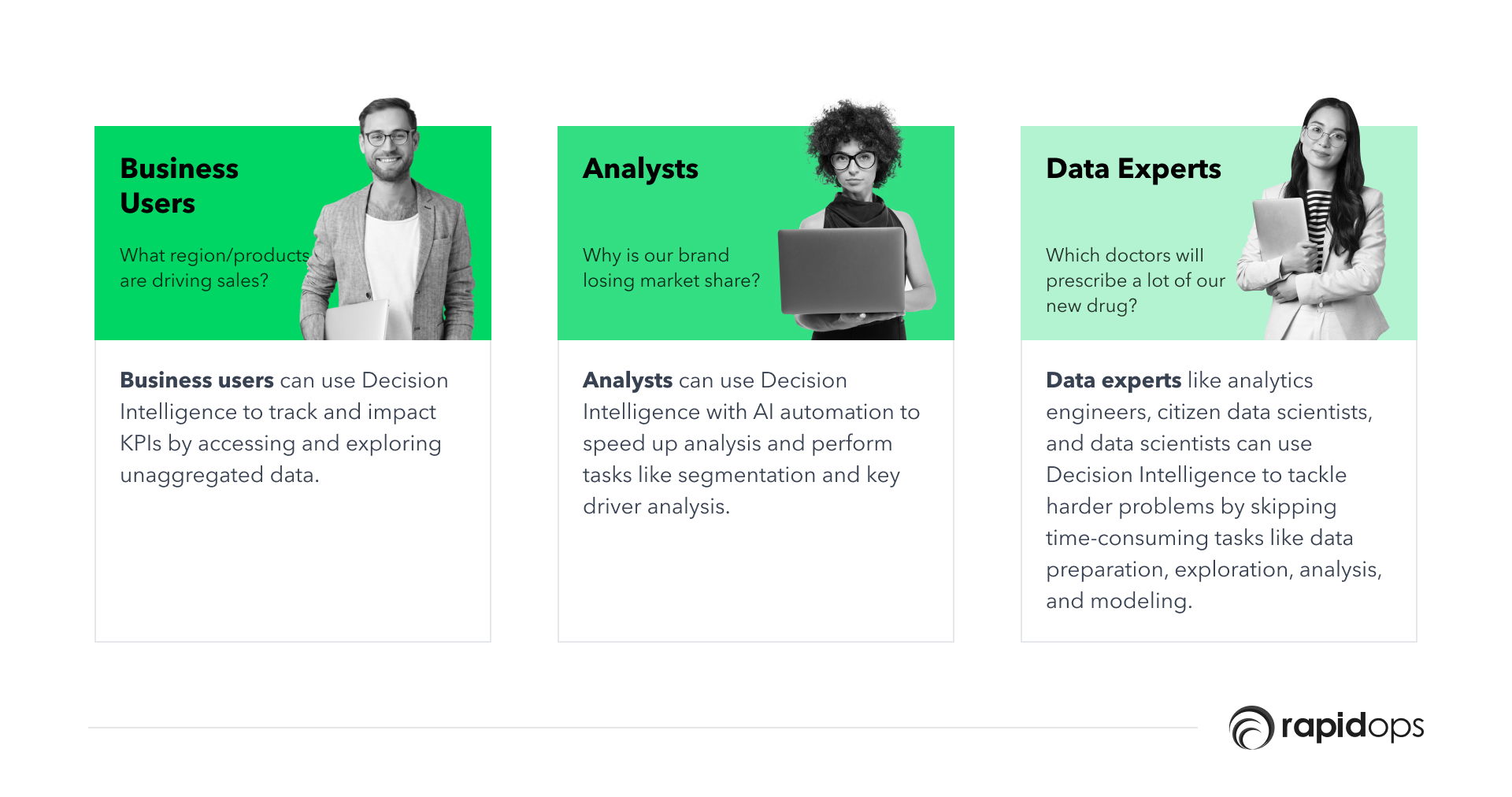
Core capabilities of decision intelligence tools for businesses
Best-in-class Decision Intelligence tools/platforms simplify the complexity of decision-making by translating business questions into natural language, applying efficient algorithms (statistical, classification, regression), and presenting answers back to users in an understandable and actionable format.
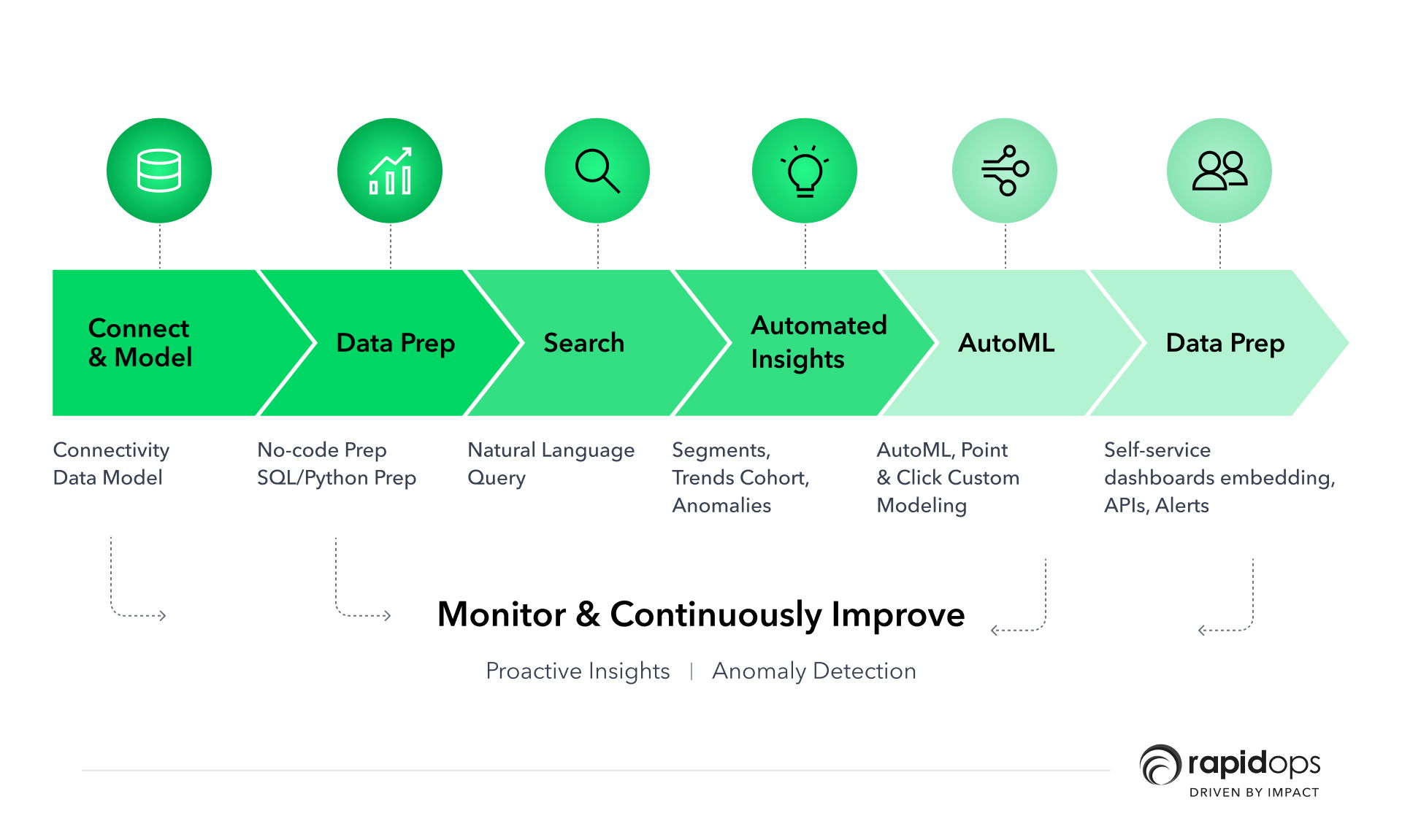
The platforms use in-memory or push-down queries to determine where the data resides and generate natural language narratives while embedding the results. This approach dramatically improves the decision-making process.
The global decision intelligence market size was estimated at USD 8,928.79 million in 2020 and is expected to reach USD 15,602.06 million by 2026.
Let's see some core capabilities of DI tools that can come in handy for businesses.
1. Data integration
DI tools integrate data from various sources to provide a comprehensive view of the business landscape. They can connect to multiple data sources, such as enterprise data warehouses, big data platforms, and cloud-based systems.
2. Analytics automation
DI tools automate time-consuming or tedious aspects of analysis, such as data preparation, feature engineering, and model selection. This helps analysts and data scientists to focus on higher-value tasks such as model interpretation and decision-making.
3. AI-driven insights
DI tools use artificial intelligence (AI) to provide deeper insights and uncover hidden patterns in data. They use machine learning algorithms to identify segments, drivers, cohort analysis, market share analysis, and more.
4. Predictive analytics
DI tools democratize predictive analytics by putting it in the hands of business users, not just data scientists. This enables businesses to make data-informed decisions quickly and effectively.
5. Collaboration and knowledge sharing
DI tools foster collaboration and knowledge sharing across teams, enabling organizations to leverage the collective intelligence of their workforce. Users can share insights, models, and data across teams and departments, facilitating better decision-making.
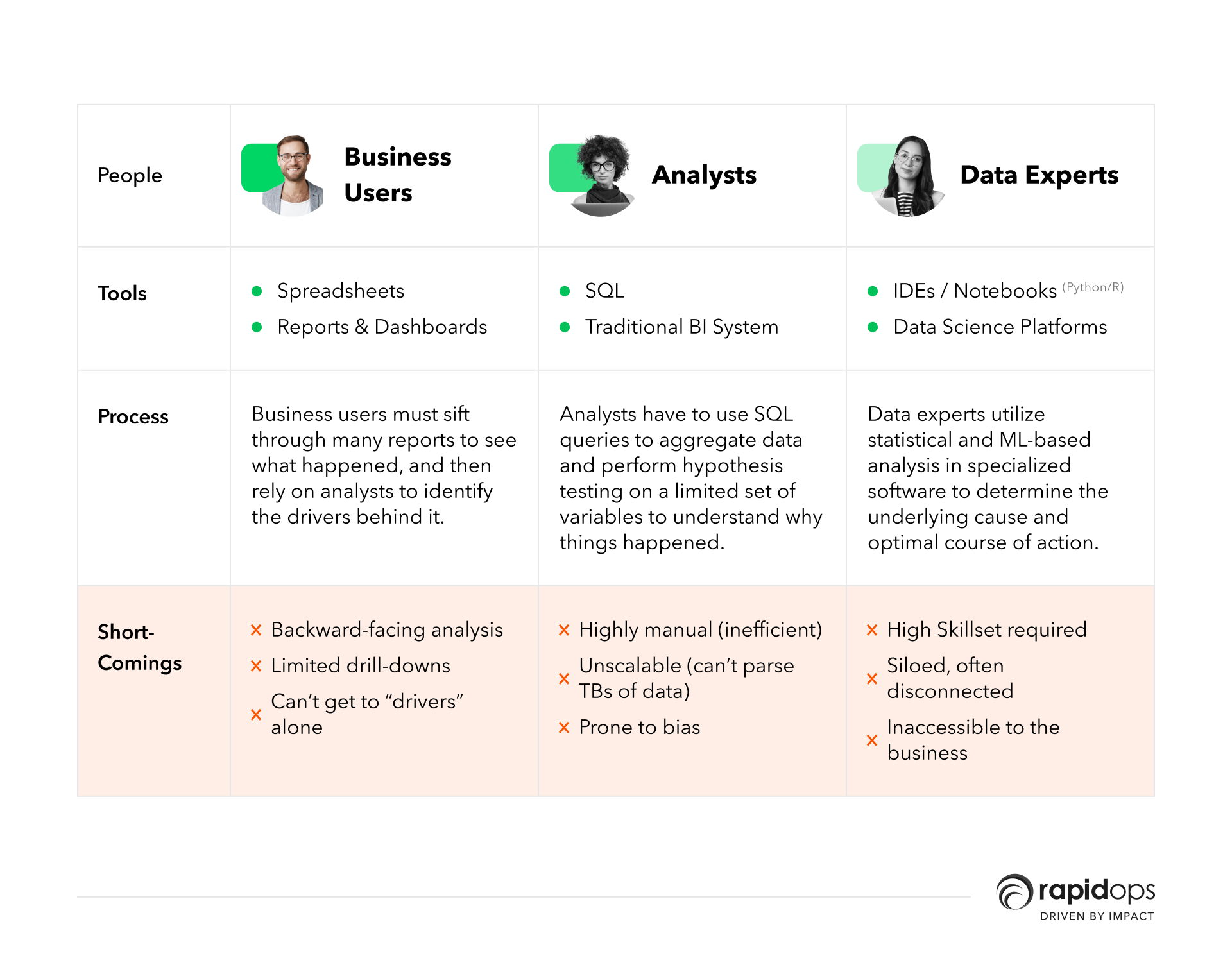
As we mentioned, current analytics workflows in organizations are siloed along the lines of people, tools, and processes.
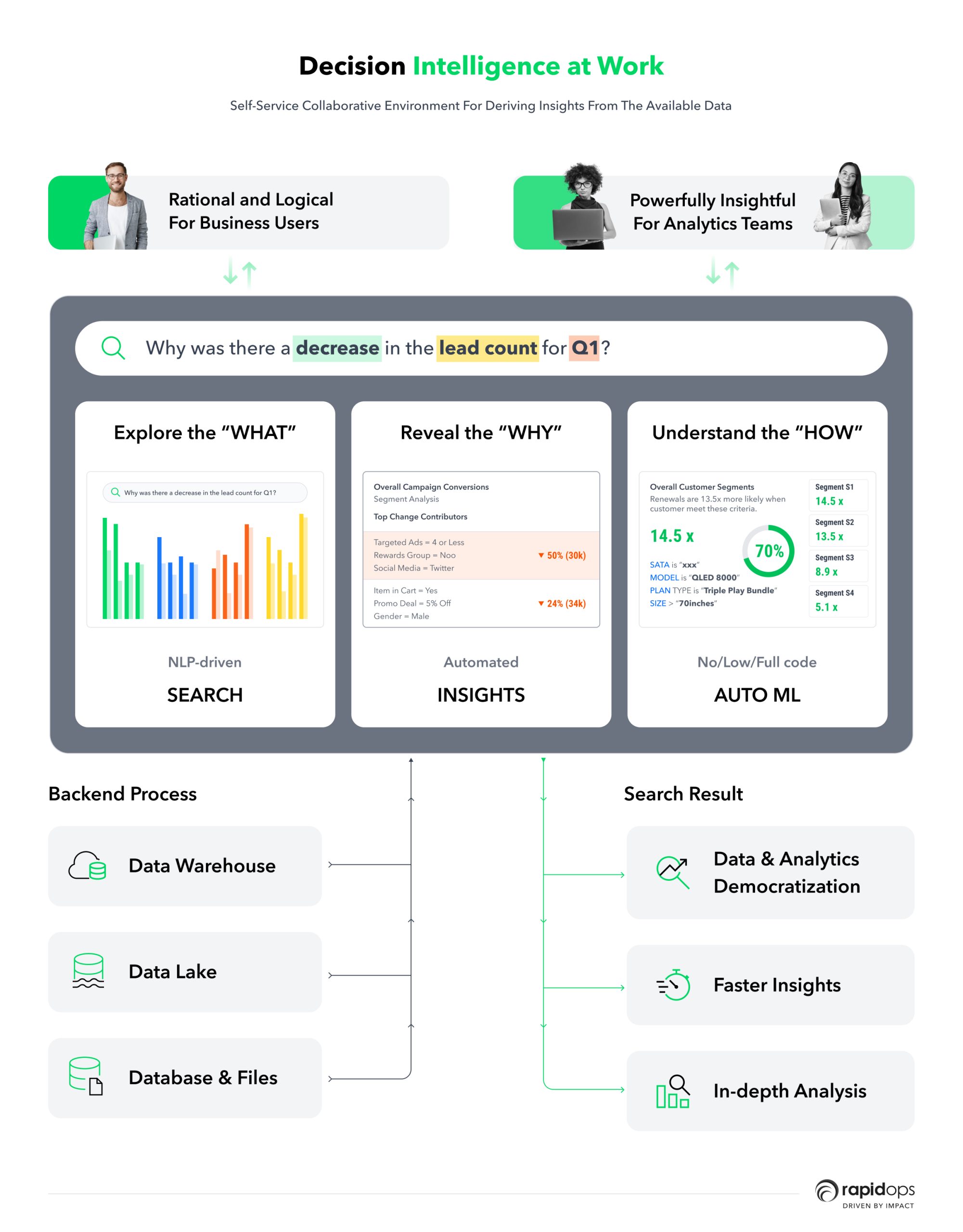
Decision Intelligence eliminates artificial barriers that exist in tools, processes, and teams, thereby enabling everyone to quickly and collaboratively address questions related to "what," "why," and "how" concerning their unaggregated data, ultimately leading to better decision-making.
What technologies make the decision intelligence model work?
This whole set of emerging technologies and algorithms empowers the decision intelligence models to work accurately and faster.
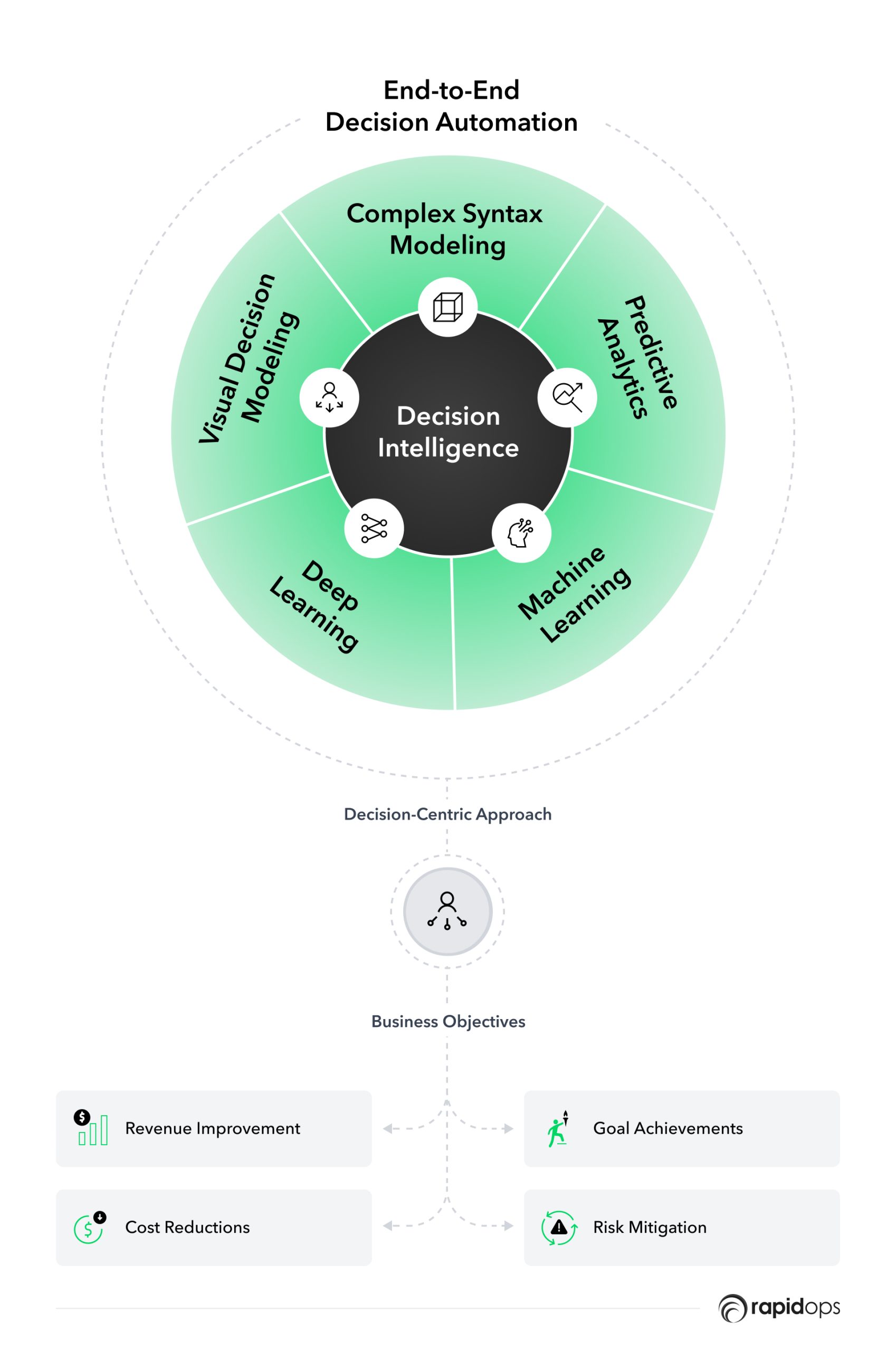
The decision intelligence model relies on a combination of different technologies and systems to function effectively. These may include:
1. Data analytics and machine learning algorithms
These technologies involve the use of software tools and techniques to process large volumes of data and identify patterns or trends that can inform decision-making. This may involve analyzing historical data to identify trends and patterns, or using predictive modeling to forecast future outcomes based on historical data.
Machine learning algorithms, in particular, can learn from large volumes of data to identify patterns and make predictions with increasing accuracy over time.
2. Predictive modeling
Predictive modeling involves the use of statistical algorithms to make predictions about future events or outcomes based on historical data. This technology can be used to forecast sales trends, predict customer behavior, or anticipate market conditions, among other things.
3. Natural language processing (NLP)
NLP is a branch of artificial intelligence that focuses on enabling machines to understand and interpret human language. This technology enables machines to interact with people more efficiently and accurately, which is critical for decision-making.
4. Visualization tools
Visualization tools help to present data and insights in a way that is easy to understand and can aid in decision-making. These tools may include charts, graphs, or other visualizations that help to highlight important patterns or trends in data.
5. Optimization algorithms
Optimization algorithms help to identify the best course of action to achieve a specific objective, taking into account multiple variables and constraints. These algorithms can be used to optimize business processes, allocate resources more efficiently, or make other decisions that require balancing competing factors.
6. Decision support systems (DSS)
A decision support system is a computer-based system that provides interactive decision-making support to users based on data, models, and other relevant information. DSS may incorporate several of the above technologies to provide users with relevant data and insights to make better-informed decisions.
Decision intelligence use cases across industries
Let's see which businesses from different sectors use decision intelligence solutions to make smarter decisions and establish sustainability and resiliency.
1. Healthcare
Decision intelligence can help doctors make more accurate diagnoses by analyzing patient data that includes medical history, symptoms, and lab results. The insights can allow reduction in human errors and improve patient outcomes.
2. Finance
In the finance industry, decision intelligence can help make better investment decisions by analyzing data on stocks, bonds, and other assets. Investors can easily identify trends and make more informed decisions about when to buy, sell, or hold different investments.
3. Manufacturing
Decision intelligence can optimize production processes and reduce wastage. By analyzing production line data, manufacturers can identify and remove bottlenecks and inefficiencies to improve productivity and reduce related costs.
4. Retail
Retailers can improve their supply chain management and inventory control by implementing decision intelligence platforms for analyzing sales data and customer behavior. This will allow them make better demand prediction and ensure that they stock the right products.
5. Transportation
Decision intelligence can be used to optimize routes and improve scheduling. By analyzing data on traffic patterns and other factors, travel companies can improve the travel time and fuel costs while also improving safety.
Concluding thoughts: Unlock insightful decision-making with a powerful decision intelligence tool
If you are still mining data to get crucial insights, you could be at the losing end. It's high time for you to reverse this process and make smarter decisions that directly target your set goals—wondering, how? Here, decision intelligence comes into the picture.
Emerging technologies like artificial intelligence and machine learning have changed the business world's standards. These technologies have completely evolved the business intelligence platforms. Their combination is like the cherry on a cake, empowering decision intelligence significantly.
Decision intelligence tools can be invaluable for businesses looking to make better and more efficient decisions. With these platforms' advanced algorithms and natural language generation capabilities, data silos can be broken down, complexity can be simplified, and predictive analytics can become democratized.
Rapidops offers tailored digital solutions that are sophisticated, intuitive, and perfectly match the specific needs of our clients. Get in touch with us today to discuss how our decision-intelligence tool can help you unlock insightful decision-making and drive real business value.

Saptarshi Das
Content Editor
9+ years of expertise in content marketing, SEO, and SERP research. Creates informative, engaging content to achieve marketing goals. Empathetic approach and deep understanding of target audience needs. Expert in SEO optimization for maximum visibility. Your ideal content marketing strategist.
What’s Inside
- Critical challenges of business decision-making
- Defining decision intelligence
- Why is decision intelligence critical?
- Benefits of decision intelligence
- Who is decision intelligence for?
- Core capabilities of decision intelligence tools for businesses
- Decision intelligence use cases across industries
- Concluding thoughts: Unlock insightful decision-making with a powerful decision intelligence tool

Let’s build the next big thing!
Share your ideas and vision with us to explore your digital opportunities
Similar Stories
- Analytics
- undefined Mins
- July 2019


Receive articles like this in your mailbox
Sign up to get weekly insights & inspiration in your inbox.


